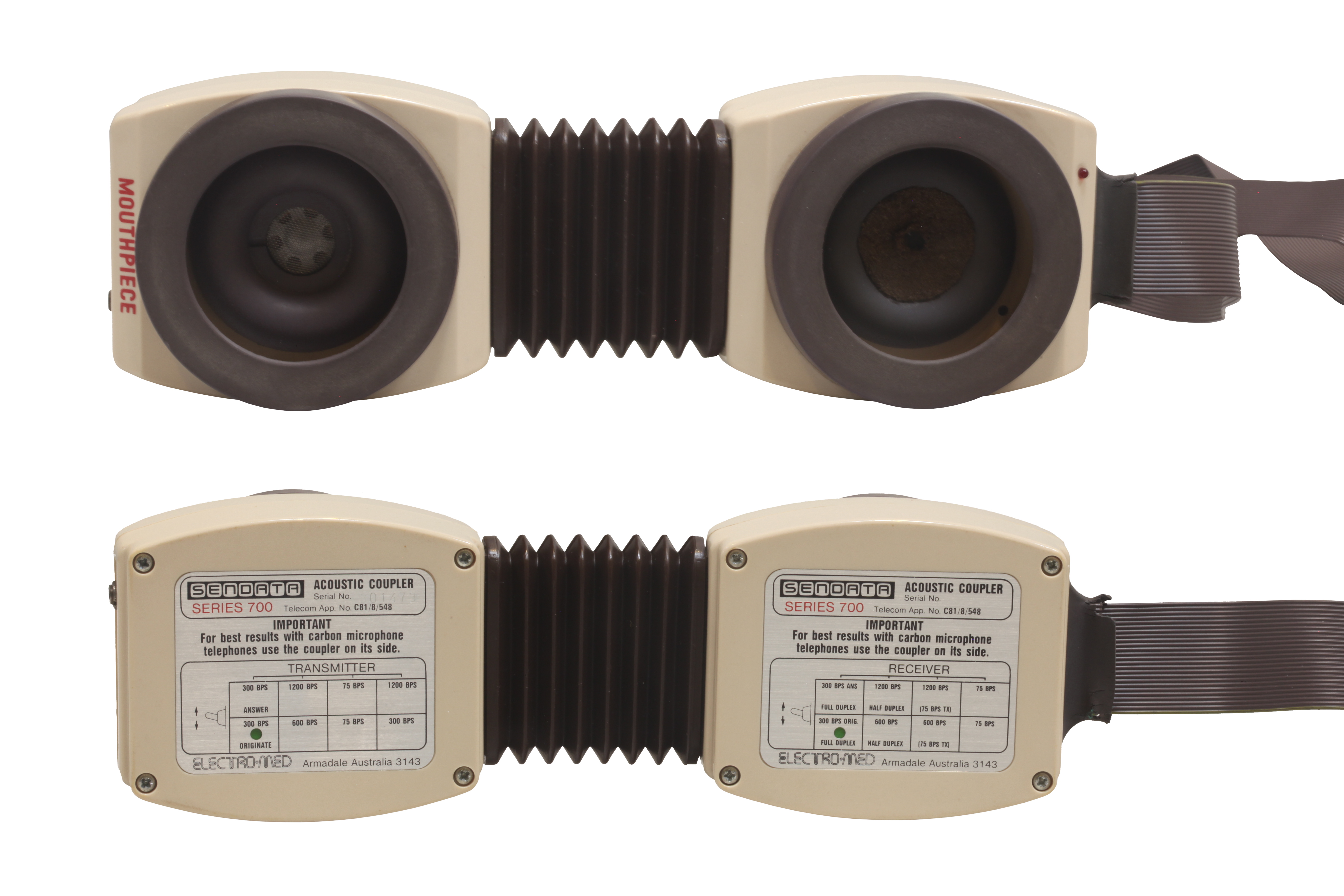|
Smartmodem
Hayes Microcomputer Products was a US-based manufacturer of modems. The company is known for the Smartmodem, which introduced a control language for operating the functions of the modem via the serial interface, in contrast to manual operation with front-panel switches. This ''smart modem'' approach dramatically simplified and automated operation. Today almost all modems use a variant of the Hayes AT command set. Hayes was a major brand in the modem market from the introduction of the original 300 bit/s Smartmodem in 1981. They remained a major vendor throughout the 1980s, periodically introducing models with higher throughput. Their competition through this period was primarily from two other high-end vendors, USRobotics and Telebit, while other companies mostly sold into niches or were strictly low-end offerings. In the early 1990s a number of greatly cost-reduced high-performance modems were released by competitors, notably the SupraFAXModem 14400 in 1992, which eroded price ... [...More Info...] [...Related Items...] OR: [Wikipedia] [Google] [Baidu] |
Hayes AT Command Set
The Hayes command set (also known as the AT command set) is a specific command language originally developed by Dale Heatherington and Dennis Hayes for the Hayes Smartmodem in 1981. The command set consists of a series of short text strings which can be combined to produce commands for operations such as dialing, hanging up, and changing the parameters of the connection. The vast majority of dial-up modems use the Hayes command set in numerous variations. The command set covered only those operations supported by the earliest modems. When new commands were required to control additional functionality in higher speed modems, a variety of one-off standards emerged from each of the major vendors. These continued to share the basic command structure and syntax, but added any number of new commands using some sort of prefix character for Hayes and USRobotics, and for Microcom, for instance. Many of these were re-standardized on the Hayes extensions after the introduction of ... [...More Info...] [...Related Items...] OR: [Wikipedia] [Google] [Baidu] |
Novation CAT
Novation, Inc., is an early modem manufacturer whose CAT series were popular in the early home computer market in the late 1970s and early 1980s, notably on the Apple II. The Hayes Microcomputer Products, Hayes Smartmodem 300, introduced in 1981, helped kill off Novation and many other early modem companies over the next few years. The Original CAT Novation's first CAT was an external 300 bit/s Bell 103-standard modem that connected to the phone lines using an acoustic coupler. Like most other acoustically coupled modems, the CAT required the user to dial the desired number on a normal telephone, listening to the call connecting and the eventual presence of an answer tone. If the dialling was successful, the user then pressed the handset down into rubber cups on the modem to connect. This was only possible because telephones were generally available only from Western Electric, all of a standardized size and layout. There was no sort of automated operation available; even hangin ... [...More Info...] [...Related Items...] OR: [Wikipedia] [Google] [Baidu] |
SupraFAXModem 14400
The SupraFAXModem 14400 is a v.32bis modem. When it was launched by Supra, Inc. in January 1992 for ,Difference sources list the price between $349 and $399 the 14,400 bit/s model was less expensive than most existing 9600 bit/s models. This price/performance ratio made it a disruptive technology, and its introduction drove modem prices sharply downward. Whereas a 9600 bit/s modem was perhaps $599 before its introduction, by the end of the year, $250 14400 bit/s modems were not uncommon. Background Supra had been a small player in the computer market through the mid-to-late 1980s, known originally for their external hard drives for the Atari ST and a variety of follow-on products. During 1991, Rockwell International's chip-making arm developed a new modem driver chipset that included all of the latest standards that were then under development. Supra, never having been known as a "player" in the modem world, designed a modem based on the new chipset, and arranged a short- ... [...More Info...] [...Related Items...] OR: [Wikipedia] [Google] [Baidu] |
Acoustic Coupler
In telecommunications, an acoustic coupler is an interface device for coupling electrical signals by acoustical means—usually into and out of a telephone. The link is achieved through converting electric signals from the phone line to sound and reconverting sound to electric signals needed for the end terminal, such as a teletypewriter, and back, rather than through direct electrical connection. History and applications Prior to its breakup in 1984, Bell System's legal monopoly over telephony in the United States allowed the company to impose strict rules on how consumers could access their network. Customers were prohibited from connecting equipment not made or sold by Bell to the network. The same set-up was operative in nearly all countries, where the telephone companies were nationally owned. In many households, telephones were hard-wired to wall terminals before connectors like RJ11 and BS 6312 became standardized. The situation was similar in other countries. I ... [...More Info...] [...Related Items...] OR: [Wikipedia] [Google] [Baidu] |
Public Company
A public company is a company whose ownership is organized via shares of share capital, stock which are intended to be freely traded on a stock exchange or in over-the-counter (finance), over-the-counter markets. A public (publicly traded) company can be listed on a stock exchange (listing (finance), listed company), which facilitates the trade of shares, or not (unlisted public company). In some jurisdictions, public companies over a certain size must be listed on an exchange. In most cases, public companies are ''private'' enterprises in the ''private'' sector, and "public" emphasizes their reporting and trading on the public markets. Public companies are formed within the legal systems of particular states and so have associations and formal designations, which are distinct and separate in the polity in which they reside. In the United States, for example, a public company is usually a type of corporation, though a corporation need not be a public company. In the United Kin ... [...More Info...] [...Related Items...] OR: [Wikipedia] [Google] [Baidu] |
Financial Data Sciences
Finance refers to monetary resources and to the study and discipline of money, currency, assets and liabilities. As a subject of study, is a field of Business Administration wich study the planning, organizing, leading, and controlling of an organization's resources to achieve its goals. Based on the scope of financial activities in financial systems, the discipline can be divided into personal, corporate, and public finance. In these financial systems, assets are bought, sold, or traded as financial instruments, such as currencies, loans, bonds, shares, stocks, options, futures, etc. Assets can also be banked, invested, and insured to maximize value and minimize loss. In practice, risks are always present in any financial action and entities. Due to its wide scope, a broad range of subfields exists within finance. Asset-, money-, risk- and investment management aim to maximize value and minimize volatility. Financial analysis assesses the viability, stability, and prof ... [...More Info...] [...Related Items...] OR: [Wikipedia] [Google] [Baidu] |
Computer Bus
In computer architecture, a bus (historically also called a data highway or databus) is a communication system that transfers data between components inside a computer or between computers. It encompasses both hardware (e.g., wires, optical fiber) and software, including communication protocols. At its core, a bus is a shared physical pathway, typically composed of wires, traces on a circuit board, or busbars, that allows multiple devices to communicate. To prevent conflicts and ensure orderly data exchange, buses rely on a communication protocol to manage which device can transmit data at a given time. Buses are categorized based on their role, such as system buses (also known as internal buses, internal data buses, or memory buses) connecting the CPU and memory. Expansion buses, also called peripheral buses, extend the system to connect additional devices, including peripherals. Examples of widely used buses include PCI Express (PCIe) for high-speed internal connectio ... [...More Info...] [...Related Items...] OR: [Wikipedia] [Google] [Baidu] |
On-hook
In telephony, on-hook and off-hook are two states of a communication circuit. On subscriber telephones the states are produced by placing the handset onto or off the hookswitch. Placing the circuit into the off-hook state is also called ''seizing the line''. ''Off-hook'' originally referred to the condition that prevailed when telephones had a separate earpiece (''receiver''), which hung from its switchhook until the user initiated a telephone call by removing it. When off hook the weight of the receiver no longer depresses the spring-loaded switchhook, thereby connecting the instrument to the telephone line. Off-hook The term off-hook has the following meanings: * The condition that exists when a telephone or other User (telecommunications), user instrument is in use, i.e., during Dialling (telephony), dialing or communicating. * A general description of one of two possible Signaling (telecommunications), signaling states at an interface between telecommunications systems, such ... [...More Info...] [...Related Items...] OR: [Wikipedia] [Google] [Baidu] |
Center Frequency
In electrical engineering and telecommunications, the center frequency of a filter or channel is a measure of a central frequency between the upper and lower cutoff frequencies. It is usually defined as either the arithmetic mean or the geometric mean of the lower cutoff frequency and the upper cutoff frequency of a band-pass system or a band-stop system. Typically, the geometric mean is used in systems based on certain transformations of lowpass filter designs, where the frequency response is constructed to be symmetric on a logarithmic frequency scale. The geometric center frequency corresponds to a mapping of the DC response of the prototype lowpass filter, which is a resonant frequency sometimes equal to the peak frequency of such systems, for example as in a Butterworth filter. The arithmetic definition is used in more general situations, such as in describing passband telecommunication systems, where filters are not necessarily symmetric but are treated on a linear fr ... [...More Info...] [...Related Items...] OR: [Wikipedia] [Google] [Baidu] |
Mainframe Computer
A mainframe computer, informally called a mainframe or big iron, is a computer used primarily by large organizations for critical applications like bulk data processing for tasks such as censuses, industry and consumer statistics, enterprise resource planning, and large-scale transaction processing. A mainframe computer is large but not as large as a supercomputer and has more processing power than some other classes of computers, such as minicomputers, server (computing), servers, workstations, and personal computers. Most large-scale computer-system architectures were established in the 1960s, but they continue to evolve. Mainframe computers are often used as servers. The term ''mainframe'' was derived from the large cabinet, called a ''main frame'', that housed the central processing unit and main computer memory, memory of early computers. Later, the term ''mainframe'' was used to distinguish high-end commercial computers from less powerful machines. Design Modern mainfr ... [...More Info...] [...Related Items...] OR: [Wikipedia] [Google] [Baidu] |
Minicomputer
A minicomputer, or colloquially mini, is a type of general-purpose computer mostly developed from the mid-1960s, built significantly smaller and sold at a much lower price than mainframe computers . By 21st century-standards however, a mini is an exceptionally large machine. Minicomputers in the traditional technical sense covered here are only small relative to generally even earlier and much bigger machines. The class formed a distinct group with its own software architectures and operating systems. Minis were designed for control, instrumentation, human interaction, and communication switching, as distinct from calculation and record keeping. Many were sold indirectly to original equipment manufacturers (OEMs) for final end-use application. During the two-decade lifetime of the minicomputer class (1965–1985), almost 100 minicomputer vendor companies formed. Only a half-dozen remained by the mid-1980s. When single-chip CPU microprocessors appeared in the 1970s, the defi ... [...More Info...] [...Related Items...] OR: [Wikipedia] [Google] [Baidu] |




